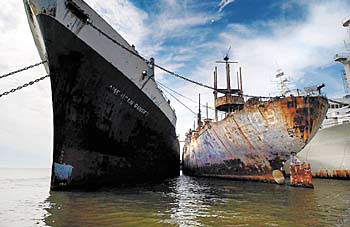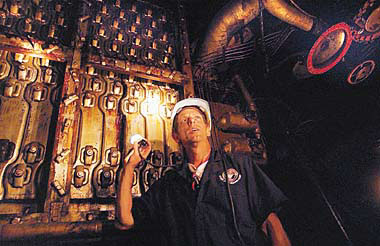By PAUL CLANCY, The
Virginian-Pilot
© August 8, 2003
ON THE JAMES RIVER -- The
exposed parts of its deck are pumpkin-colored by rust, its hull a flaking mess.
Its gun turrets are empty tubs. Spiders ride webs like trampoline gymnasts.
This is an undignified state for a one-time Navy ship that took American
troops into combat in the Pacific during World War II, for the last of a breed
of famous workhorses.
But down steep stairways, in the belly of the attack transport Gage, there
are no signs of leaks. The ship's engine room, its berthing spaces, its machine
shop, its boilers -- seem almost pristine.
The Gage, named for a county in Nebraska, landed Marines and other troops on
Okinawa, the last of the Pacific islands to fall before the Japanese surrender.
After the war, it was decommissioned in Norfolk and sent to the ``Ghost
Fleet'' on the river. And never called on again. Because it was essentially
ignored for more than half a century, the Gage is considered the last authentic
member of its class.
But sometime next year -- the date hasn't been set -- the Gage is expected to
be towed into the Atlantic, 50 miles or more offshore, where some Navy vessel
will lie in wait.
On command, the ``live-fire training exercise'' is to blast the tough old
survivor and send it to its final resting place 6,000 feet or more below.
But maybe not.
A group of veterans and history buffs has begun a petition drive and lobbying
campaign to save the Gage and turn it into a floating museum on the unsung but
crucial vessels that helped win the war in the Pacific.
``Attention all hands!'' cries the group's Web site. ``General Quarters! This
is not a drill!''
The group is the APA Historical Preservation Project, dedicated to saving as
many as possible of the ``auxiliary fleet, personal complement, attack force''
ships that were built in huge numbers in Portland, Ore., near the end of the
war.
These APAs were the Navy versions of the famed Victory Ships, the merchant
vessels that risked sinking by enemy submarines to carry troops and supplies
overseas. The APAs bristled with guns. Their payload was Marines.
Of 230 built, the Gage is the last originally configured attack transport,
the group says. A few others still exist, but they've been significantly
modified.
The 455-foot Gage, capable of carrying more than 500 crewmen, 1,500 troops
and 2,900 tons of cargo, was launched in October 1944.
Beginning April 1, Easter Sunday, 1945, it landed 6th Division Marines on
Okinawa.
The 29-year-old Lt. Ernest Rhodes was in charge of one of the landing craft
that hit the beach that morning. Rhodes, 88, who later taught theater history at
Old Dominion University, remembers the sloping beach, the airfield on his left,
small town on his right. Behind, boats carrying Marines and gear were lined up
in waves.
The landing was unopposed, but the significance of the battle that won the
island lives in his thoughts.
``That was the greatest moment in my life,'' he says. ``I was doing something
of value for my country.''
The skipper of the Gage, then-Cmdr. Leroy Alexanderson, took command when the
ship went into service at Astoria, Ore. Alexanderson, 93, who later became
commodore of the passenger ship United States, lives in Hampton.
He remembers lecturing his crew: ``You came here for one purpose -- to get
those troops safely ashore.'' And they did.
After the war, the Gage took part in the ``magic carpet'' rides that brought
troops home. It came straight to Norfolk and then, after decommissioning in
February 1947, was placed in the ``Ghost Fleet,'' now officially known as the
James River Reserve Fleet. There it has remained, essentially untouched.
That's the remarkable thing about the Gage, says writer Peter Stoudt, one of
the APA organizers. Because little was done to change it, ``this thing is an
archaeological dig.'' The group wants the museum's theme to be ``forever 1945.''
Stoudt hopes it can be adopted by a group in Hampton Roads, where there is a
significant number of amphibious sailors or Portland, where the Gage was built.
Tom Gonzalez began the drive to save the Gage. The native Long Islander
served on the Rockbridge, an APA that was based in Norfolk, during the Cuban
missile crisis. That ship was cut up for scrap and Gonzalez, now a volunteer for
Habitat for Humanity on the Eastern Shore -- and a docent on the battleship
Wisconsin -- decided a delivery wagon, as well as a battle wagon, ought to be
honored.
The battleships might have ``softened up'' the Pacific islands prior to the
invasions, Gonzalez says, ``But if you didn't put the Marines on the beach, they
would still be Japanese islands today.''
Despite its years, the Gage's hull is in better condition than many of the
other ships in the James River fleet, according to the U.S. Maritime
Administration, which oversees them.
Marine surveyor Alyn Fife, who looked at the Gage, says it was in ``pretty
sad shape'' and estimated it would cost $10 million to restore. Stoudt believes
that with volunteer help, the bill should be half that.
Either way, it's a lot of money, but groups in San Francisco, Baltimore and
Tampa, Fla., have restored World War II-era merchant ships and now take
passengers on local voyages.
Norfolk already has its battleship, and a major fund-raising campaign on its
behalf is under way.
Whether or not the area could take on a restoration project for another World
War II icon is a question that the Gage group will have to answer.
First, a stay of execution must be granted.
The Navy has a regular program of sinking old ships to train crews and test
weapons. According to a spokeswoman, the Navy needs particular-size targets for
specific weapons. Each year, one or more candidates for ``sinkex'' are chosen
from inactive fleets around the country.
Next year will be the Gage's turn -- unless the Navy and the Maritime
Administration can be persuaded to find a new target while petitioners develop
their plan for saving the ship.
For now, on a morning that begins with light rain, the Gage waits between two
other ships, the American Ranger, which was recently sold for scrap, and the
Vandenburg, a candidate for a diving reef.
Down in the Gage's engine room, doors to the big boilers are ajar.
Flashlights play over bricks inside that absorbed the heat but did not keep the
engineers who worked them from suffering in extreme heat.
The berthing space has row after row of steel bunks with mattress springs.
The head, with toilets and sinks and showers, is free of graffiti, surely
because of gallons of paint.
But there are stories that no amount of paint could erase from the memories
of many who were carried by the Gage.
Mike Furby, a Maritime Administration electrician, has never been to sea, but
he feels the history of the ships wherever he goes among the ghosts of the
fleet.
``I come out here and go 'round the world,'' he says. ``I come out here and
get a little history every day.''
Reach Paul Clancy at paul.clancy@pilotonline.com or 446-2627.
| The attack
transport Gage, right, landed Marines and other troops on Okinawa.
After the war, it was
decommissioned in Norfolk and sent to the Ghost Fleet on the James
River. |

|
|
|

